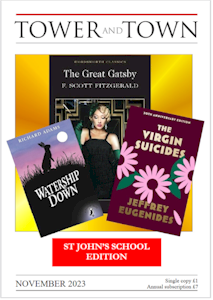

Tower and Town, November 2023 (view the full edition) (view the full edition)Thoughts Invoked By LiteratureYear 11 Student, Imogen Granger reviews one of Roald Dahl’s lesser-known stories ‘The Minpins’ is a story written by Roald Dahl, and while it is certainly not his best work, it conveys strong ideas and opinions that people in modern society can still relate to and feel a connection with. Many people haven’t heard of ‘The Minpins’, and when you buy a complete Roald Dahl box set, it is not included. I know the story well, and I found this absence intriguing, so I decided to find out what spurred the decision to place this book in a separate category to the others. In other Dahl stories, there is most usually a strongly communicated moral. For example, in numerous books - ‘James and the Giant Peach’, ‘George’s Marvellous Medicine’, ‘Matilda’, and ‘The Twits’ - we see a running theme of revenge and well-deserved comeuppance. Most definitely with ‘Charlie and the Chocolate Factory’, the message to the younger readers is almost threatening: that those who are selfish, greedy and ignorant will not be excused by society, and we see Dahl’s lack of compassion through the character of Willy Wonka, who parted with the tormented children with considerable glee and pride. We also see certain independence through the young protagonists – who are often surrounded by characters who embody laziness and cruelty, traits that are immediately looked down upon by readers. There is a certain feeling of compassion and admiration felt for these children as they are neglected and thrown into impossibly wicked situations by their elders. These themes contrast greatly from the book ‘The Minpins’, Dahl’s last book, which was written for his daughter, Ophelia. The main character, Billy, is the epitome of everything that we expect from a young child – he is wildly curious, adventurous, and easily swayed. Our first recognition of this difference in character is sparked when Dahl uses a rather dark and brooding metaphor of the Devil ‘whispering’ in order to personify Billy’s disobedient and rebellious thoughts. Almost immediately after Billy gives into the persuasion of ‘The Devil’, he is faced with a consequence to his actions: a near-death experience due to the appearance and pursuit of the villainous ‘Gruncher’, a ‘Jabberwocky’-esque creature. During his escape, Billy meets the Minpins – tiny people who have been subjected to living in the trees because of the ‘Gruncher’. Billy’s accidental involvement with their daily battle with death makes us realise that while Billy is presented as the protagonist, he really lacks any hero status, and is just observing the persecution of a completely separate entity. In Dahl’s other books, the main characters are said to have been faced with hardship throughout their whole lives. For example, George from ‘George’s Marvellous Medicine’ had been living with his repellent grandmother effectively bullying him for years, and because of this, we relish her disappearance/ possible death, as our sympathy towards George fuels our yearning for his vengeance against his grandmother. The same desire for revenge is not provoked when reading ‘The Minpins’. While the ‘Gruncher’ evidently intends to kill Billy and the Minpins, it seems immoral to class it as ‘evil’ or even ‘villainous’, as its actions are purely animalistic, no matter how frightful it is made to sound. In Dahl’s other stories, the ‘villain’ is always human, and it is the constant back and forth conflict between their actions and the protagonist’s that causes their retribution to be amusing and satisfactory to the reader. Contrastingly, when the ‘Gruncher’ is finally defeated, while we feel relief for both Billy and the Minpins, we don’t find humour in the death as we would have in other books. Consequently, the story lacks the certain and confident ending that we are so used to in Dahl’s typical stories; the protagonist didn’t really experience any loss or gain. This evident contrast in story lines, themes and morals gives us an extra facet of understanding of Roald Dahl’s literary spectrum and provides us with an insight into another side of him. Since this was published after his death, it is uncertain as to whether he wrote this when he was unwell, and if that’s where the change in tone came about, or if as it was written for his daughter, it was far more personal, heartfelt and honest. In addition, the book did not receive the Quentin Blake illustrations until 2017, and the original book contains far more realistic pictures that lack the slapstick flair that is featured in the other books; perhaps this also contributed to the underlying seriousness. In conclusion, the messages that are communicated in ‘The Minpins’ are both intriguing and admirable, leaving it open to criticism. This makes it enticing for all ages, and therefore, I think that it most definitely should be read. Imogen Grange (y11) |